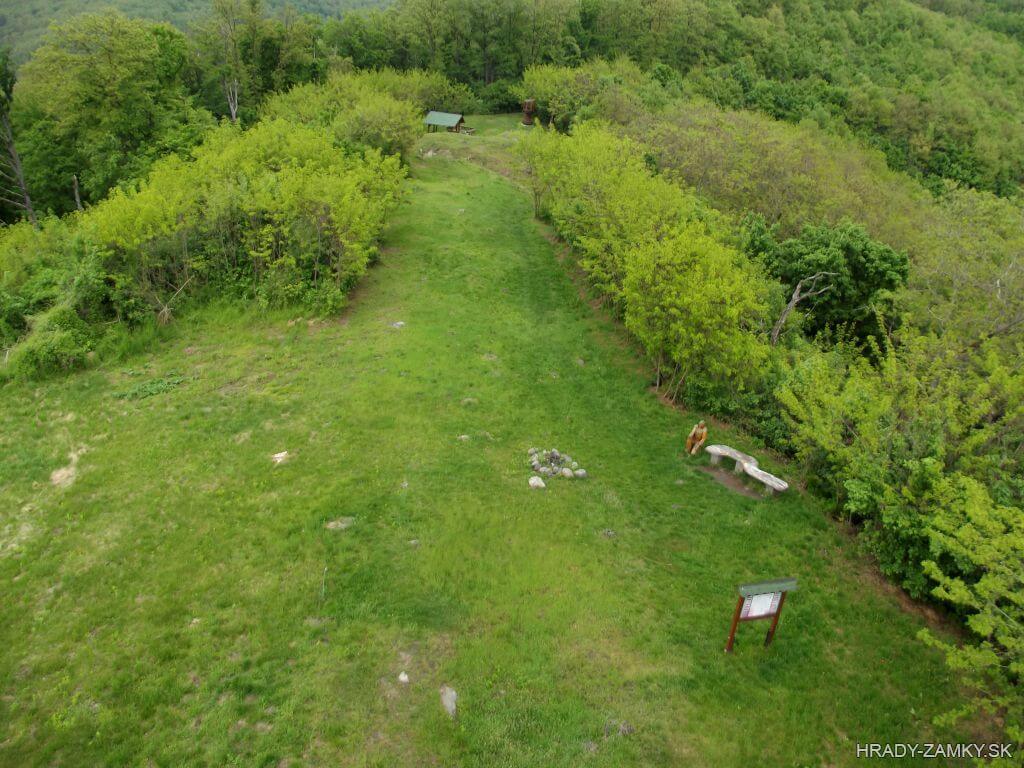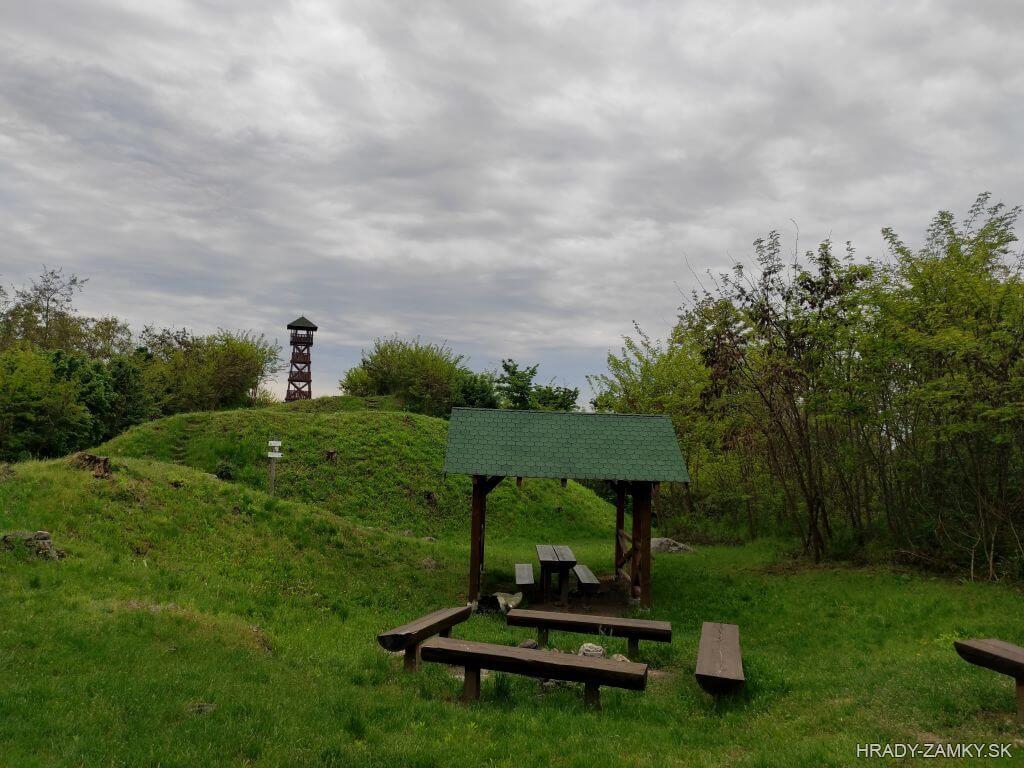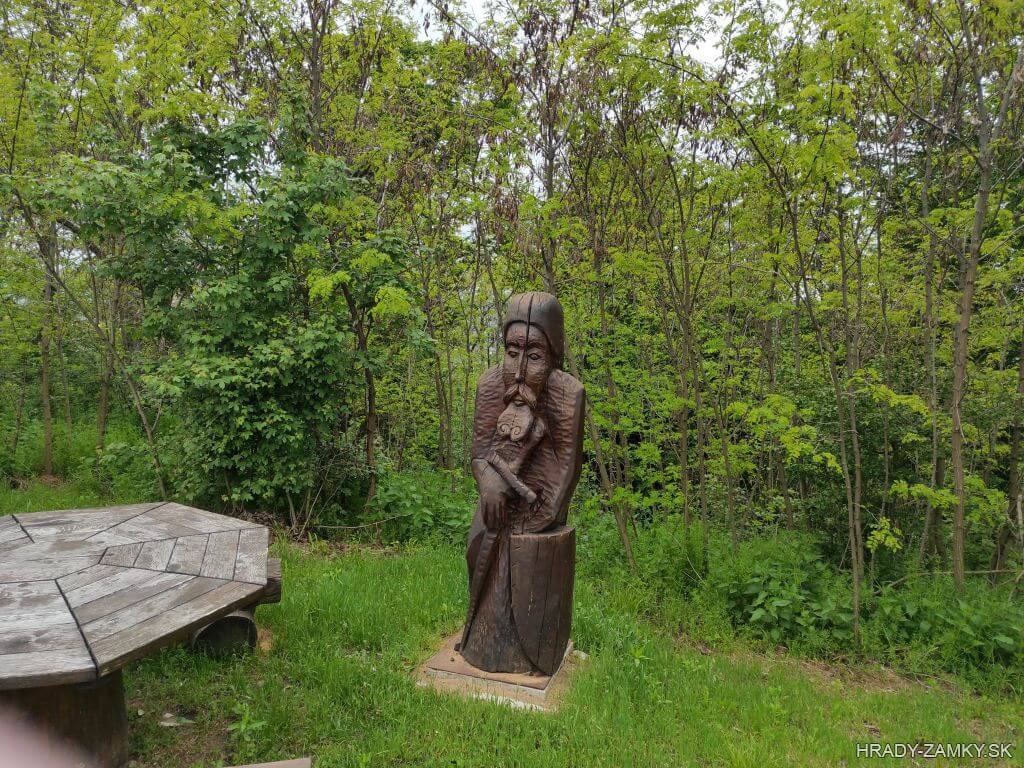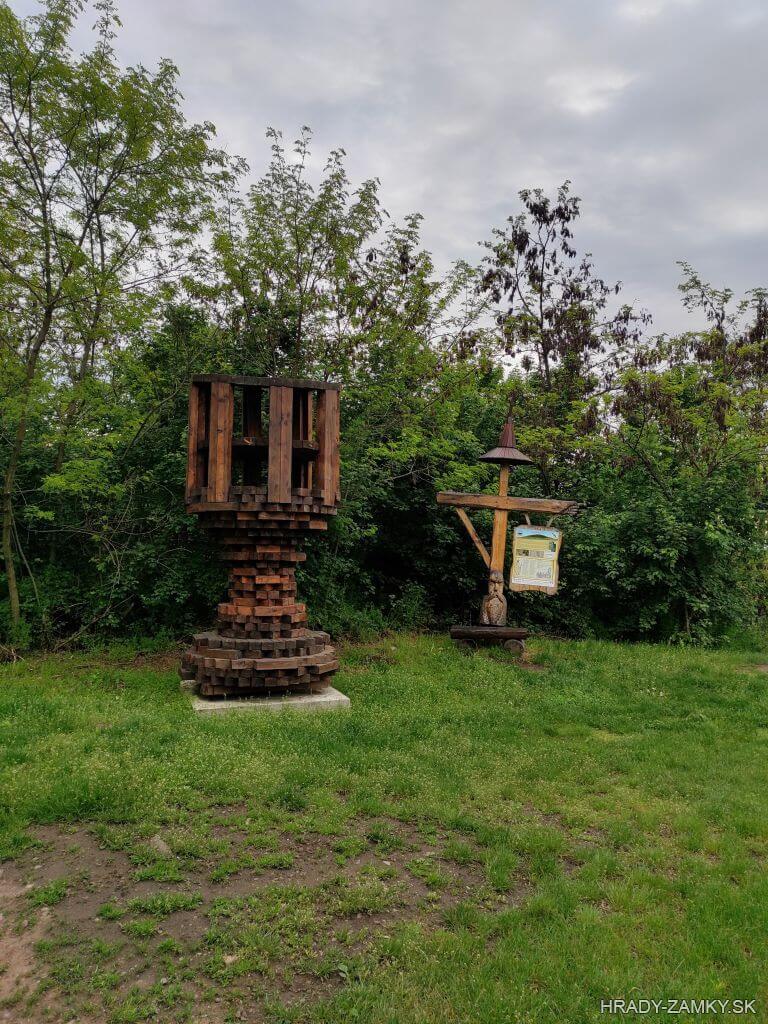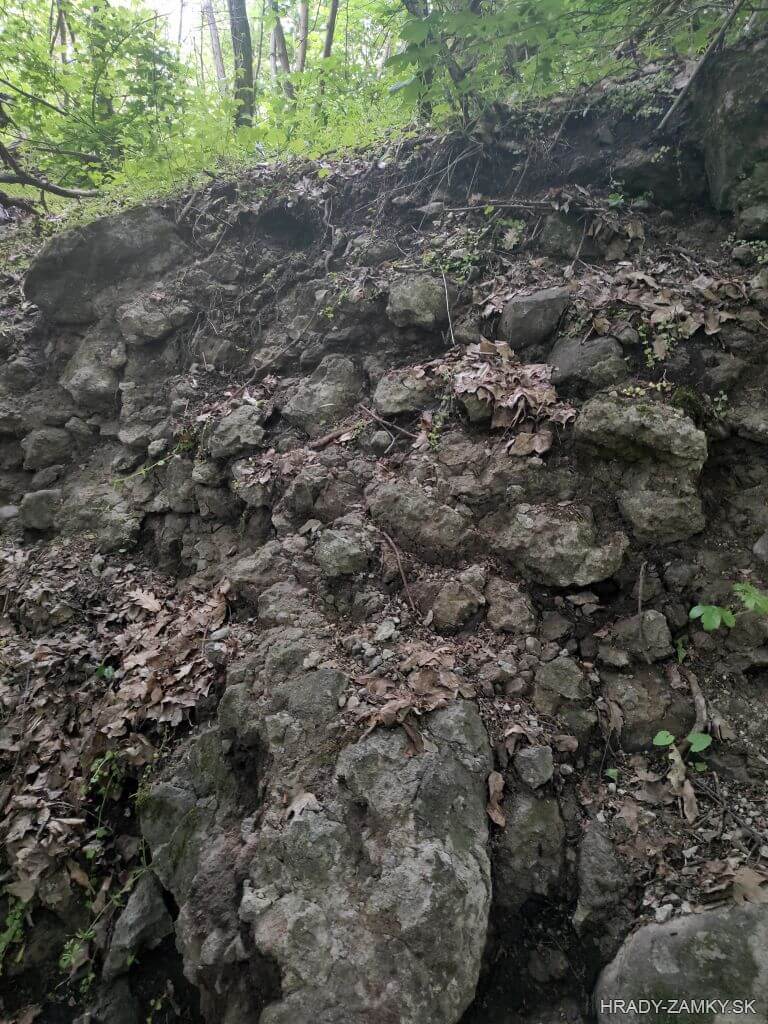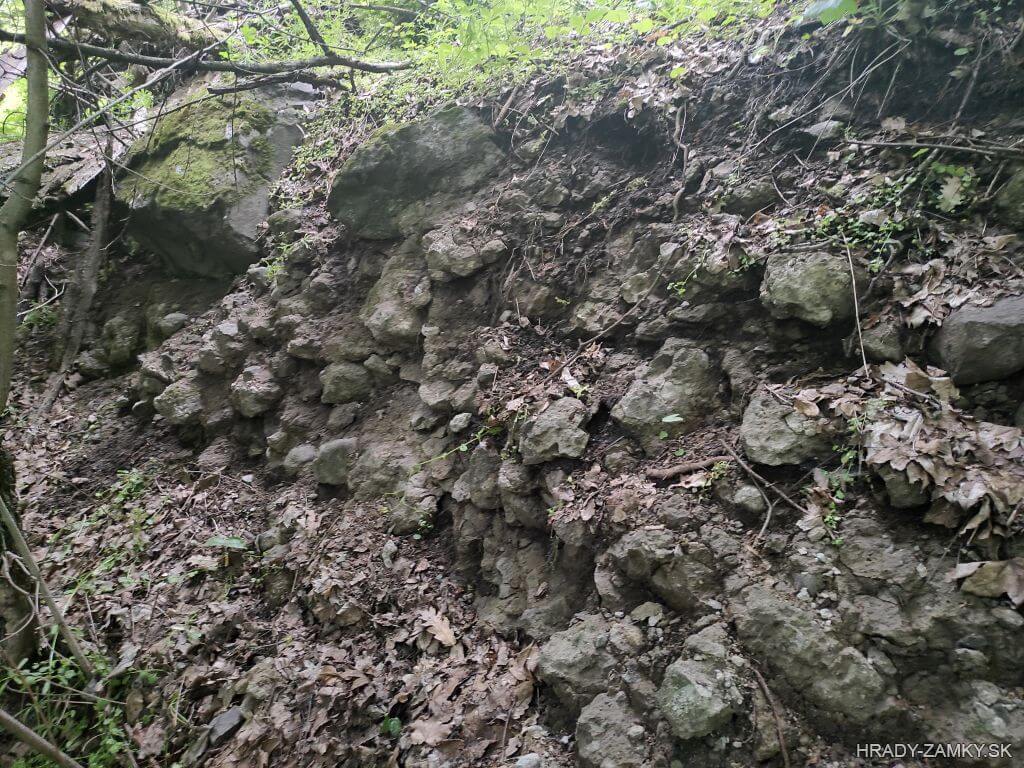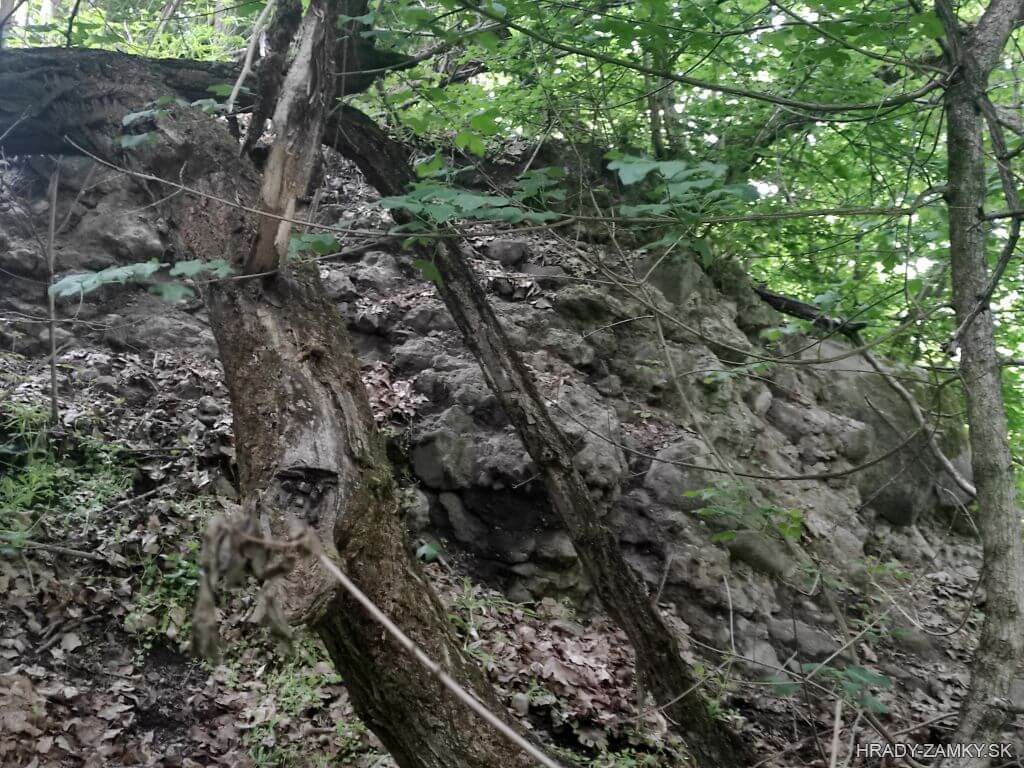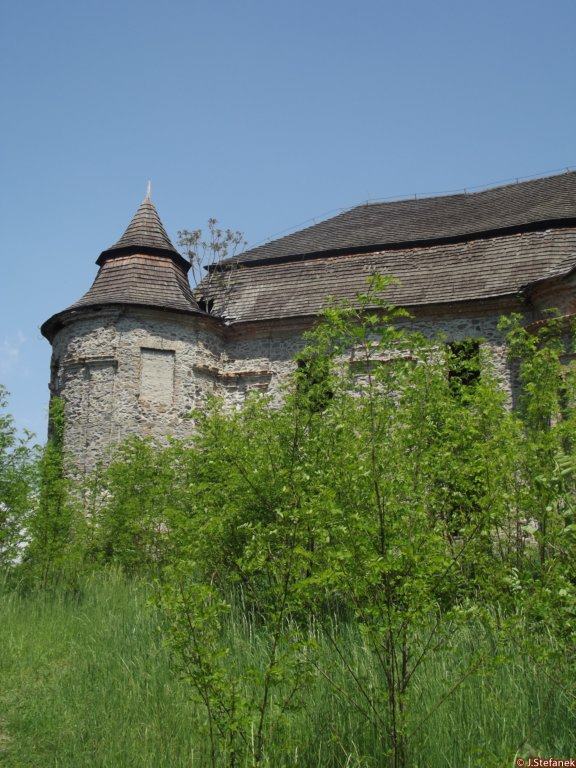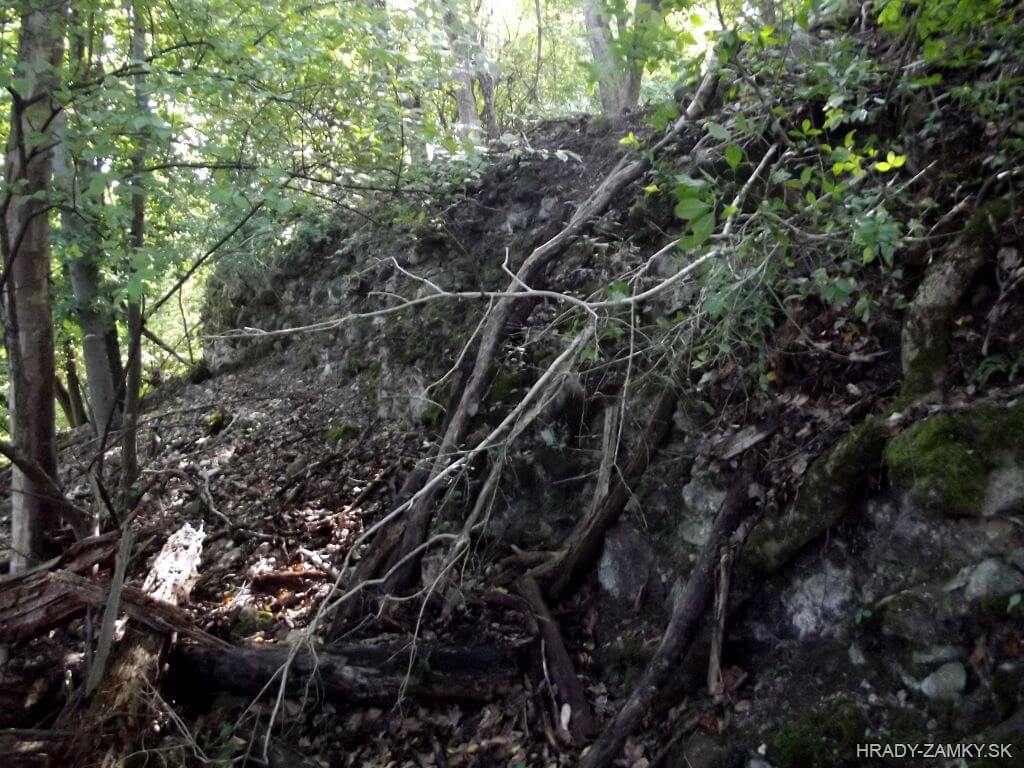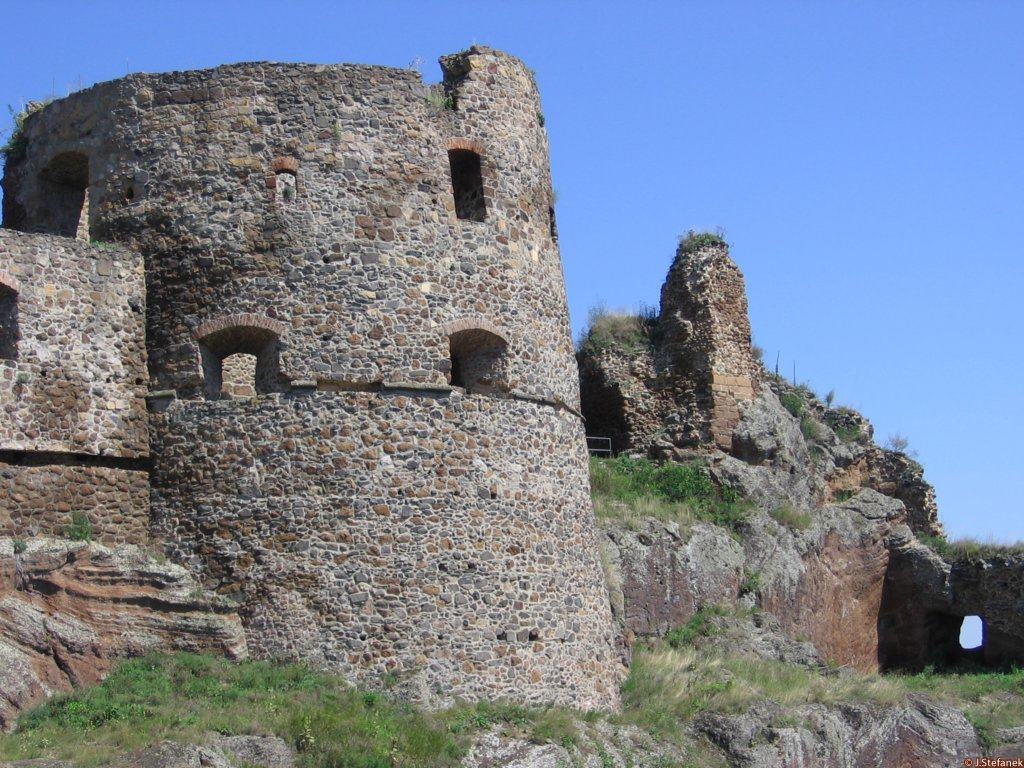Maginhrad
Nižný Skálnik Banská Bystrica county Slovakia
extinct castle
Maginhrad
Nižný Skálnik Banskobystrický kraj Slovakia
zaniknutý hrad
In the past, the castle of the same name was located on the top plateau of Maginhrad, the slight remnants of which are located in the forest around the plateau, north of Rimavská Sobota in the Revúcka vrchovina
Na vrcholovej plošine Maginhradu sa v minulosti rozprestieral rovnomenný hrad, ktorého nepatrné zvyšky múrov sa nachádzajú v lesnom poraste v okolí plošiny, severne od Rimavskej Soboty v pohorí Revúcka vrchovina
Previous names
Magin, Mogavár
Roads
Trasa 1: The easiest access is the route from the village of Horné Zahorany. Here we can park at the bell tower on a small square and from there a leisurely walk almost along the plain along the yellow TZT, first through an open meadow, which then enters the forest. Before entering the forest at Čerťaz, we choose the yellow route on the left, because the road straight will take us down to the village of Nižný Skálnik. Later we will come to another crossroads and the yellow route on the right will take us to the top of the lookout tower, where the castle once stood.In the forest, about 50 m to the south-west of the lookout tower, there are stone formations, similar to the remains of walls, but according to historians, these are volcanic eruptions and no remains have been preserved from the castle.
Trasa 1: Najjednoduchším prístupom je trasa z obce Horné Zahorany. Tu môžeme zaparkovať pri zvonici na malom námestí a odtiaľ pohodovou prechádzkou takmer po rovine po žltej TZT najprv cez otvorenú lúku, ktorá potom vstupuje do lesa. Pred vstupom do lesa pri Čerťazi zvolíme žltú trasu vľavo, pretože cesta rovno nás zavedie dolu do obce Nižný Skálnik. Neskôr prídeme k ďalšiemu rázcestiu a žltou trasou vpravo sa dostaneme až na vrchol k rozhľadni, kde kedysi stál hrad.V lese, zhruba 50m na J-JZ od rozhľadne sa nachádzajú kamenné útvary, podobné zvyškom múrov, no podľa historikov sa jedná o sopečné vyvreniny a z hradu sa nezachovali žiadne zvyšky.
Trasa 2: The route from Nižný Skálnik along the green route is more demanding, but the access under the hill is part of the educational trail In the footsteps of Maginhrad and the path is made more pleasant by wooden sittings and statues. The path is initially undemanding, but after entering the meadow into the forest, a more significant ascent begins, but it does not take long.
Trasa 2: Trasa z Nižného Skálnika po zelenej TZT je síce náročnejšia, avšak prístup pod kopec je súčasťou náučného chodníka Po stopách Maginhradu a cestu spríjemňujú drevené posedenia i sochy. Cesta je spočiatku nenáročná, po vstupe z lúky do lesa však začína výraznejšie stúpanie, no netrvá dlho.
Trasa 3: In Malé Teriakovce we can park in the northern part of the village either at the church and the cemetery, or at the crossroads, from where we will continue on foot across the meadow along the yellow route, which later enters the forest and at the end feeds the green route.
Trasa 3: V Malých Teriakovciach môžeme zaparkovať v severnej časti obce buď pri kostole a cintoríne, alebo pri rázcestí, odkiaľ budeme pokračovať peši cez lúku po žltej TZT, ktorá neskôr vstupuje do lesa a pri konci sa napája na zelenú trasu.
Description
It was probably a wooden castle originally. The narrow layout extends over a length of more than 100 m and is separated from the ridge by a pair of extremely wide and deep ditches and a massive rampart. The outer moat was 15 m wide and the inner one more than 20 m wide.The flat surface itself does not bear traces of the perimeter fence or of any objects. The platform currently has a lookout tower, shelter, benches and wooden statues.
Pôvodne sa zrejme jednalo o drevený hrad. Úzka dispozícia sa ťahá v dĺžke viac ako 100 m a od hrebeňa je oddelená dvojicou mimoriadne širokých a hlbokých priekop a masívnym valom. Vonkajšia priekopa mala šírku 15 m a vnútorná vyše 20 m.Samotná rovinná plocha nenesie stopy obvodovej ohrady ani priehlbiny po nejakých objektoch. Na plošine v súčasnosti stojí rozhľadňa, prístrešok, lavičky a drevené sochy.
Plan
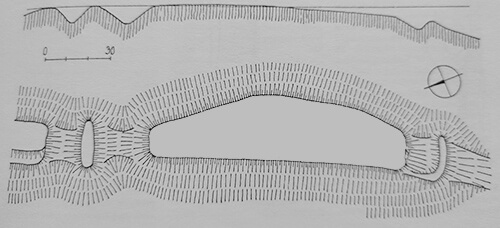
Legenda k pôdorysu
- Zdroj: PLAČEK M.
- BÓNA M.
- Encyklopédia slovenských hradov
History
Lokalita Maginhradu bola osídlená už v bronzovej dobe. Predstavuje výšinné polykultúrne sídlisko z obdobia neolitu, eneolitu, staršej doby bronzovej a stredoveku. Zo severnej strany je opevnená sústavou mohutných valov. Najstaršie osídlenie kopca bolo preukázané keramickými fragmentmi bukovohorskej a lengyelskej kultúry.
V stredoveku na Maginhrade stál hrad (hrádok), postavený pravdepodobne v 13. až 14. storočí. Mal oválny pôdorys a zrejme i vodnú priekopu s valom. Archeológovia v tejto oblasti našli ďalší keramický materiál z 13. storočia. Pravdepodobne sa nejednalo o pevnosť s veľkým významom. Historik L.Sokolovský predpokladá využitie tejto lokality vojskom Jána Jiskru, ktorí tu mohli mať svoju pevnosť, a zánik pevnosti spája s ich vyhnaním.
Sokolovský taktiež predložil dve teórie majetkovej držby v údolí Rimavy. Ak by v 13. storočí lokalita Maginhradu patrila k majetkom rodu Hunt-Pázmányovcov, mohol pokus o založenie hradu predchádzať stavbe tamojšiemu opevnenému kaštieľu. Ak však lokalita patrila kaločským arcibiskupom, do úvahy by pripadalo až obdobie po roku 1341, keď vojvoda Tomáš Séchényi pripojil oddelené panstvo v okolí k hradu Šomoška a jeho odľahlosť mohla vyvolať zriadenie miestneho správneho centra.
V historických prameňoch sa o hrade nezachovali žiadne relevantné zmienky, no predpokladá sa, že k zániku hradu došlo v 15. storočí, keď ho dobyl Matej Korvín.
Archeológ Alexander Botoš tu robil menší archeologický výskum v roku 2014, ktorý predchádzal stavbe rozhľadne. Uvádza, že na mieste, kde v súčasnosti rozhľadňa stojí a ani v predpokladanom hradnom areáli nebol v minulosti vykonaný žiadny archeologický výskum.
Prvé archeologické nálezy z lokality Maginhrad sú však známe už zo začiatku 20. storočia, keď výskum vykonával poloprofesionálny archeológ a spoluzakladateľ Gemerského župného múzea Ľudovít Hűvössy (1858 – 1939). Z tohto výskumu pochádzajú vyššie spomínané keramické nálezy.
Nadzemné múry ani konštrukcie hradu sa podľa výskumu nezachovali, predpokladá sa, že hrad bol skôr drevenej konštrukcie a mal charakter strážneho hrádku alebo tvrdze. Asi 50 m na JZ od rozhľadne je v lese badať nános kameňov, pripomínajúci múry. Väčšina internetových zdrojov uvádza, že sa jedná o zvyšky kamenných múrov hradu (viď fotografie v galérii), no historici a odborníci tieto kamene stotožňujú so sopečnými vyvreninami. Uviesť tieto fakty na pravú mieru a tiež priniesť viac informácií o pôvodnom hrade by snáď mohol len komplexný archeologický výskum.
Oblasť Maginhradu so 17 m vysokou turistickou rozhľadňou v súčasnosti predstavuje atraktívnu turistickú lokalitu.
Lokalita Maginhradu bola osídlená už v bronzovej dobe. Predstavuje výšinné polykultúrne sídlisko z obdobia neolitu, eneolitu, staršej doby bronzovej a stredoveku. Zo severnej strany je opevnená sústavou mohutných valov. Najstaršie osídlenie kopca bolo preukázané keramickými fragmentmi bukovohorskej a lengyelskej kultúry.
V stredoveku na Maginhrade stál hrad (hrádok), postavený pravdepodobne v 13. až 14. storočí. Mal oválny pôdorys a zrejme i vodnú priekopu s valom. Archeológovia v tejto oblasti našli ďalší keramický materiál z 13. storočia. Pravdepodobne sa nejednalo o pevnosť s veľkým významom. Historik L.Sokolovský predpokladá využitie tejto lokality vojskom Jána Jiskru, ktorí tu mohli mať svoju pevnosť, a zánik pevnosti spája s ich vyhnaním.
Sokolovský taktiež predložil dve teórie majetkovej držby v údolí Rimavy. Ak by v 13. storočí lokalita Maginhradu patrila k majetkom rodu Hunt-Pázmányovcov, mohol pokus o založenie hradu predchádzať stavbe tamojšiemu opevnenému kaštieľu. Ak však lokalita patrila kaločským arcibiskupom, do úvahy by pripadalo až obdobie po roku 1341, keď vojvoda Tomáš Séchényi pripojil oddelené panstvo v okolí k hradu Šomoška a jeho odľahlosť mohla vyvolať zriadenie miestneho správneho centra.
V historických prameňoch sa o hrade nezachovali žiadne relevantné zmienky, no predpokladá sa, že k zániku hradu došlo v 15. storočí, keď ho dobyl Matej Korvín.
Archeológ Alexander Botoš tu robil menší archeologický výskum v roku 2014, ktorý predchádzal stavbe rozhľadne. Uvádza, že na mieste, kde v súčasnosti rozhľadňa stojí a ani v predpokladanom hradnom areáli nebol v minulosti vykonaný žiadny archeologický výskum.
Prvé archeologické nálezy z lokality Maginhrad sú však známe už zo začiatku 20. storočia, keď výskum vykonával poloprofesionálny archeológ a spoluzakladateľ Gemerského župného múzea Ľudovít Hűvössy (1858 – 1939). Z tohto výskumu pochádzajú vyššie spomínané keramické nálezy.
Nadzemné múry ani konštrukcie hradu sa podľa výskumu nezachovali, predpokladá sa, že hrad bol skôr drevenej konštrukcie a mal charakter strážneho hrádku alebo tvrdze. Asi 50 m na JZ od rozhľadne je v lese badať nános kameňov, pripomínajúci múry. Väčšina internetových zdrojov uvádza, že sa jedná o zvyšky kamenných múrov hradu (viď fotografie v galérii), no historici a odborníci tieto kamene stotožňujú so sopečnými vyvreninami. Uviesť tieto fakty na pravú mieru a tiež priniesť viac informácií o pôvodnom hrade by snáď mohol len komplexný archeologický výskum.
Oblasť Maginhradu so 17 m vysokou turistickou rozhľadňou v súčasnosti predstavuje atraktívnu turistickú lokalitu.
Myths and legends
The story of Maginhrad (Ľ. Janota)
Starlight landed on the old ruins of Maginhrad. There is a grave silence around ... Everything is silent ... everything, dreamy, fell into the arms of a clear night ... The twelve o'clock, the hour of ghosts is coming ... The ruins of the castle seem to come to life, as if mysterious, invisible figures from other worlds ... Twelve o'clock struck. She staggered over the castle and stood up, as if in astonishment, a large star shining with a very bright glow. She was the brightest in the sky. It seemed as if she was slowly descending from the sky to the ground and falling among the rums. And then at once the four castle windows looked into the night with a bright light. Where did this hall come from, when the castle has been lying in rum for centuries and the time above it has long been pronounced the eagle of death? Unknown. Miraculously, it repeats itself year after year. Nature has its secrets that human ingenuity will never understand. Let's not think about it, but rather look at the irradiated hall ... Four gloomy, massive walls. The hall gives the impression of an ancient crypt, where the centuries-old bones of our grandfathers and great-grandfathers have been dusty ... The old knights look at the chalice with gloomy glances. They stand motionless, as if carved out of marble. They all have pale, icy faces with long gray chins. They don't breathe. Everyone is serious about expecting something terrible. A miracle should happen in a few minutes. The knight, who stands behind the summit and leans on a large, rusted sword, watches the gloomest. A minute flies by a minute, and each seems to be a mystery anticipation of eternity. Read more...
But knights don't move ... they don't give the slightest sign of life ... And yet they all live their strange, incomprehensible lives ... They live, though they don't move, it's a strange life, incomprehensible to earthlings. They came here from every other end of our country and came to life only for this one night, which is to be their salvation. And will it really be? They have gathered here so many times and parted again in the morning ... The stars float in the arms of the night like locust flies in the black forest. Even the stars shine strangely today, and the song of the breeze is kind of very strange today ... And the moon looks strangely at the ruins of the castle, as if he also wants to look into the mysterious hall and find out what's really going on there ... billions of stars have separated from their sisters and fall ... fall ... across distant worlds to the ruins of Maginhrad. The star fell into the hall, into the golden chalice ... The knights' faces darkened even more, but their eyes softened. The eldest approached the chalice and grabbed it. She holds him tight and stares at his bottom. It was as if he wanted to drown his gaze in him, which was now ignited by the winter ligot ... - The Blood of Christ - he spoke in a devout, soft voice, as when Christ was turning water into wine at the Canaanite merriment. Something was swirling in the chalice ... something was boiling and boiling in it ... The noise coming from the chalice echoed across the hall. The eldest of the knights placed the chalice to his mouth with a kind of sublime movement of his firm hand, in which he still held a rusty sword. He drank the fudge of the goblet. His face took on an unearthly expression, and his eyes were piously high. - Blood of Christ - he repeated again and handed the chalice to his neighbor. And the mysterious drink in the chalice swirled again and skype, though the knight leader drank it to the bottom. There is a silent adoration on everyone's faces. In the eyes of fire, silent enthusiasm and prayer, begging for mercy ... Knights both suffer and rejoice. They have a kind of hope, which they are not sure about fulfilling, but they desperately want. The second knight also drank the contents of the chalice. His face, too, took on an extraterrestrial expression, and a strange fire flashed in his eyes. He placed the chalice on the oak table and the chalice skype again, and there was a noise in the hall. And he took it into the hands of the third and fourth ... and thus, every time he passed, he passed through twenty-four hands. The last two hands piously placed him on the oak table, and then all the eyes fell into him. It was obvious that the last moment of expectation had arrived. The leader's face was beginning to clear, but she was saddened again, and saddened even more than before. Because the goblet skype again ... it crumbled and its red contents poured onto a heavy oak table, where the drops glow with a bright red luster. The other faces grew sad, and their eyes darkened even more. And this sadness had its cause. After all, the knights have been meeting for centuries on the day of the Ascension of the Lord in the castle hall of Maginhrad, around a heavy oak table, to strengthen themselves with the blood of Christ for a moment when the chalice stops boiling, which is supposed to be a sign and the day has come when they will be able to break out from under the earth and draw their rusty swords to defend the Slovak homeland ... They have been waiting for this sign for many centuries, but that day is not coming, the Lord God is not yet tearing the handcuffs of their servitude ... even in their souls, who would like to fly out from under the ground, taking on human form from blood and flesh, they flew into the Slovak fields as a harbinger of a more beautiful life and greater well-being of our Slovak people. Well, the chalice always throws again ... They saden again, their faces glaze and their eyes obscure expectations ... The knights no longer look at the chalice, their eyes are inserted into the icy face of their leader.
He just looks at the chalice, as if to make sure once again that the Lord God does not yet want to draw his rusty swords. There is a grave silence. The stars float across the sky like the calm distances of the sea. They went out two ... three ... ten died ... a hundred ... one hundred thousand ... and they all went out ... there was only one left. And this last, the brightest, falls to the ground, as one of her sisters was lowered at midnight. He falls slowly, silently. It sits, radiantly glowing, on the castle ruins, which are lit by a tar ditch. Brightness everywhere, ligot, blinding light ... The rooster crowed. The brightness of the star turned pale. The light was gone, he would have been swallowed up by some stout black parrot. And then a mysterious noise swirled in the castle again; some figures seemed to fly over his ruins again. Twelve knights flew with the light of a jagged star, flew on its wings to return to the ruins of the castle in a year, to a mysterious room ... They left because there was no time for them. The chalice also disappeared. The sound of the murmur of Christ's blood ... this noise bounces off the walls and fits into the nascent day to fill the Maginhrad ruins one year again with the hopes of cursed knights waiting with rusted swords in the bowels of the earth beneath Maginhrad for a command for a more beautiful future of the homeland of Slovaks ... And when the blood of Christ in the chalice stops boiling and boiling, knights will rise and the whirlwind will run through the forests and fields of Slovakia to eradicate everything that is not unique that undermines the future of our homeland. Their swords will gleam in the jagot of the sun, and woe to him who hates us.
Povesť o Maginhrade (Ľ. Janota)
Svit hviezd sadol na staré zrúcaniny Maginhradu. Okolo je hrobové ticho... Všetko mlčí... všetko, zasnené, padlo do náručia jasnej noci...Prichádza dvanásta hodina, hodina duchov...Zrúcaniny hradu akoby ožili, akoby sa nad nimi rozhovorili tajomné, neviditeľné postavy z iných svetov...Dvanásta hodina odbila. Nad hradom sa mocne zajagala a zastala akoby v udivení veľká a veľmi jasnou žiarou svietiaca hviezda. Bola zo všetkých na oblohe najjasnejšia. Zdalo sa, akoby pomaly schádzala z oblohy na zem a zapadla medzi rumami. A potom naraz štyri hradné okná pozreli do noci jasným svetlom. Kde sa tu táto sieň vzala, keď hrad už od storočí leží v rumoch a čas nad ním už dávno vyslovil ortieľ smrti? Nevedno. Akýmsi zázrakom sa to opakuje rok po rok. Príroda má svoje taje, ktoré ľudský um nikdy nepochopí. Nerozmýšľajme nad tým, ale radšej sa pozrime do ožiarenej siene... Štyri chmúrne, masívne steny. Sieň pôsobí dojmom starodávnej krypty, kde od storočí práchnivejú kosti našich dedov a pradedov... V strede siene je ťažký dubový stôl, na ňom sa jagá veľký zlatý kalich. Na kalich sa pozerajú zachmúrenými pohľadmi starí rytieri. Stoja nehybne, akoby boli vytesaní z mramoru. Všetci majú bledé, ľadové tváre s dlhými šedivými bradami. Nedýchajú. Všetci hľadia vážne sťa v nejakom očakávaní niečoho strašného. Sťa by sa mal o niekoľko minút stať nejaký zázrak. Najchmúrnejšie pozerá rytier, ktorý stojí za vrchstolom a opiera sa o veľký, zahrdzavený meč. Minúta odlieta za minútou a každá sa zdá byť v tajomnom očakávaní večnosťou. Čítaj ďalej...
Ale rytieri sa nehýbu... nedávajú ani len najmenšej známky života... A predsa všetci žijú svojím zvláštnym, nepochopiteľným životom... Žijú, hoci sa nehýbu, je to divný život, pre pozemšťanov nepochopiteľný. Zišli sa sem každý z inej končiny našej vlasti a oživli len na túto jedinú noc, ktorá má byť pre nich spasením. A či naozaj bude? Veď už toľkokrát sa tu zišli a nad ránom zasa rozišli... Hviezdy plávajú v náručí noci ako svätojánske mušky v čiernom lese. I tie hviezdy dnes akosi divne svietia, i tá pieseň vetríka je dnes akási veľmi podivná... A mesiac zvláštne pozerá na zrúcaniny hradu, akoby i on chcel nazrieť do tajomnej siene a zistiť, čo sa tam vlastne deje... Odrazu jedna z miliárd hviezd sa odlúčila od svojich sestier a padá... padá... cez ďaleké svety na zrúcaniny Maginhradu. Hviezda padla do siene, do zlatého kalicha... Tváre rytierov sa zachmúrili ešte viac, ale oči zmäkli. Najstarší pristúpil ku kalichu a chytil ho do rúk. Drží ho pevne a pozerá uprene na jeho dno. Akoby v ňom chcel utopiť svoj pohľad, ktorý sa teraz zapálil zimničným ligotom... – Krv Kristova – vyriekol pobožne, mäkkým hlasom, ako keď Kristus na kanaánskom veselí premieňal vodu na víno. V kalichu sa čosi zvírilo... začalo v ňom čosi vrieť a kypieť... Šum, vychádzajúci z kalicha, sa rozľahol po sieni. Najstarší z rytierov priložil kalich k ústam s akýmsi velebným pohybom pevnej ruky, v ktorej doposiaľ držal zahrdzavený meč. Vypil šumiaci obsah kalicha na dúšok. Jeho tvár dostala nadpozemský výraz a oči sa upreli zbožne do výšok. – Krv Kristova – opakoval znovu a podal kalich svojmu susedovi. A tajomný mok v kalichu sa znovu zvíril a skypel, hoci vodca rytierov ho vypil do dna. Na tvárach všetkých sa zračí tiché zbožňovanie. V očiach oheň, tiché nadšenie a modlitba, prosiaca o zmilovanie... Rytieri i trpia, i sa radujú. Prežívajú akési nádeje, o splnení ktorých nie sú istí, ale vrúcne si to želajú. Aj druhý rytier vypil obsah kalicha na dúšok. I jeho tvár dostala nadpozemský výraz, i v jeho očiach zblkotal divný oheň. Položil kalich na dubový stôl a kalich znovu skypel a v sieni sa rozľahol šum. A vzal ho do rúk i tretí, i štvrtý... a takto skypiac zakaždým, prešiel cez dvadsaťštyri rúk. Posledné dve ruky ho zbožne položili na dubový stôl a vtedy všetky pohľady sa doň zapichli. Bolo badať, že nadišla posledná chvíľa očakávania. Tvár vodcu sa už začala vyjasňovať, ale zas zosmutnela, a zosmutnela ešte viac, ako bola predtým. Lebo kalich znovu skypel... zvrel a jeho červený obsah vykypel na ťažký dubový stôl, kde kvapky žiaria ostročerveným leskom. I ostatné tváre zosmutneli a oči sa ešte viac zachmúrili. A tento smútok mal svoju príčinu. Veď rytieri už od dlhých storočí rok po rok sa schádzajú na deň Nanebovstúpenia Pána do hradnej siene Maginhradu, okolo ťažkého dubového stola, aby sa posilnili Kristovou krvou na chvíľu, keď kalich prestane vrieť, čo má byť znamením, že čas ich podzemnej poroby už prešiel a nadišiel deň, keď sa budú môcť vyrojiť spod zeme a vytasiť zhrdzavené meče na obranu slovenskej vlasti... Už dlhé storočia čakajú na toto znamenie, ale onen deň neprichádza, Pán Boh ešte nestrháva putá ich poroby... Kalich vrie a vrie, zavše aj v ich dušiach, ktoré by rady vyleteli spod zeme vezmúc na seba ľudskú podobu z krvi a mäsa, rozleteli sa do slovenských polí ako predzvesť krajšieho života a väčšieho blahobytu nášho slovenského ľudu. No kalich vždy znovu zvrie... Oni znovu zosmutnejú, tváre zľadovejú a oči zastrie očakávanie... Rytieri už nehľadia na kalich, oči majú zapichnuté do ľadovej tváre svojho vodcu.
On pozerá len na kalich, akoby sa chcel ešte raz presvedčiť, či Pán Boh ešte nechce, aby vytasili zhrdzavené meče. Je hrobové ticho. Hviezdy plávajú po oblohe ako po pokojných diaľavách mora. Zhasli dve... tri... odumrelo ich desať... sto... stotisíc...a zhasli všetky... ostala len jediná. A táto posledná, najjasnejšia, sa spúšťa na zem, ako jedna jej sestra sa bola spúšťala o polnoci. Padá pomaly, tichúčko. Sadá, oslepujúco žiariac, na hradné zrúcaniny, ktoré svietia sťa smolná fakľa. Všade jas, ligot, oslepujúce svetlo... Kohút zakikiríkal. Jas hviezdy zbledol. Svetlo zmizlo, sťa by ho bola pohltila nejaká ozrutná čierna papuľa. A vtedy na hrade sa znovu zvíril tajomný šum; zdalo sa, sťaby ponad jeho zrúcaninami znovu preletovali akési postavy. Dvanásť rytierov uletelo so svetlom jagavej hviezdy, uleteli na jej krídlach, aby sa o rok zas vrátili na zrúcaniny hradu, do tajomnej komnaty... Odišli, lebo nebol tu ich čas. Zmizol i kalich. Čuť len šumenie Kristovej krvi... tento šum sa odráža od stien a zapadá do rodiaceho sa dňa, aby o jeden rok znova naplnil maginhradské zrúcaniny nádejami zakliatych rytierov, ktorí so zhrdzavenými mečmi čakajú v útrobách zeme pod Maginhradom na chvíľu, na povel k boju za krajšiu budúcnosť vlasti Slovákov... A keď krv Krista v kalichu prestane vrieť i kypieť, rytieri povstanú a sťa víchor prebehnú cez lesy a polia Slovenska, aby vykynožili všetko, čo nie je svojské, čo podrýva budúcnosť našej vlasti. Ich meče sa zablysnú v jagote slnca, a beda tomu, kto chová k nám nenávisť.
Useful information
The site is freely accessible
Lokalita je voľne prístupná
Nearby castles

